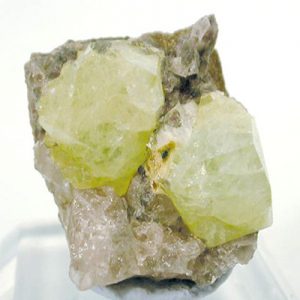Rhodizite: Gemstone Information
Rhodizite is a rare and fascinating mineral that belongs to the borate group. It was first discovered in 1800 in the Ural Mountains of Russia and later found in other locations around the world, including Madagascar, Brazil, Afghanistan, and the United States. Rhodizite derives its name from the Greek words “rhodon,” meaning rose, and “zite,” meaning stone, owing to its pinkish coloration when found in its purest form. However, it is more commonly colorless or may display hues of yellow, green, or brown.
Physical Properties:
Rhodizite possesses several distinctive physical properties:
Crystal Structure: It crystallizes in the isometric system, typically forming small, transparent crystals with a cubic or octahedral habit. These crystals often exhibit well-defined faces and sharp edges.
Hardness: Rhodizite is one of the hardest minerals known, ranking 9 on the Mohs scale, just below diamond. This exceptional hardness contributes to its durability and resistance to abrasion.
Luster: The mineral typically displays a vitreous to resinous luster, giving it a sparkling appearance when viewed under light.
Transparency: Rhodizite crystals are usually transparent, allowing light to pass through them with minimal obstruction.
Chemical Composition:
Rhodizite has a simple chemical composition, consisting primarily of boron, aluminum, and potassium. Its chemical formula is (K, Cs)Al4B4O15. The presence of trace amounts of cesium (Cs) in some specimens contributes to their unique properties. Rhodizite crystals may also contain small inclusions of other minerals or gases, which can influence their optical and physical characteristics.
Occurrence and Mining:
Rhodizite is an extremely rare mineral, and significant deposits are scarce. It is often found in association with pegmatite deposits, where it forms as a secondary mineral in the cavities and fractures of host rocks. Madagascar is one of the primary sources of gem-quality rhodizite crystals, particularly in the Ambatofinandrahana region. Mining for rhodizite is typically limited, and specimens are primarily obtained through small-scale artisanal mining operations.
Uses:
Rhodizite’s rarity and unique properties make it highly valued among collectors and enthusiasts. Some common uses and applications include:
Gemstone: Rhodizite crystals are prized by gemstone collectors for their exceptional hardness, clarity, and brilliance. While they are not widely used in jewelry due to their small size and scarcity, larger specimens may be cut and faceted into stunning gemstones for use in pendants or rings.
Metaphysical and Spiritual Practices: In alternative healing and metaphysical circles, rhodizite is believed to possess powerful energy-enhancing properties. It is often used as a meditation aid, believed to amplify positive energies and promote spiritual growth.
Scientific Research: Rhodizite’s unique crystal structure and chemical composition make it a subject of interest in scientific research, particularly in the fields of mineralogy, crystallography, and materials science. Studies on rhodizite may contribute to a better understanding of borate minerals and their potential applications.
Conclusion:
Rhodizite is a remarkable mineral renowned for its rarity, hardness, and optical properties. Despite its small size and limited availability, it holds significant value in various fields, from gemstone collecting to scientific research and metaphysical practices. As one of the hardest minerals known to man, rhodizite continues to captivate enthusiasts and researchers alike with its enduring beauty and intriguing characteristics.





